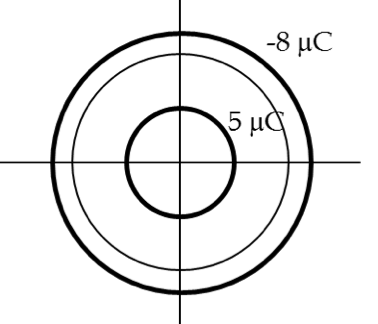1. Electric Field of Charged Metallic Spherical Shell Surrounding a Charged Metal Ball.
An aluminum spherical ball of radius \(4\text{ cm}\) is charged with \(5\ \mu\text{C}\) of charge. A copper spherical shell of inner radius \(6\text{ cm}\) and outer radius \(8\text{ cm}\) surrounds it. A total charge of \(-8\ \mu\text{C}\) is put on the copper shell.
(a) Find the electric field at all points in space including points inside the aluminum and copper shell when copper shell and aluminum sphere are concentric.

(b) Find electric potential at arbitrary point from the common center of the arrangement in part (a).
Hint.
(a) Use Gauss’s law. (b) Integrate the electric field from \(r=\infty\) to various points.
Answer.
See solution.
Solution 1. (a)
The given charge distributions have spherical symmetry. Therefore, a quick application of Gauss’s law yields the following for the electric field in various regions.
\begin{equation*}
\vec E = \begin{cases}
0 \amp r\lt 4\:\text{cm}\\
\frac{1}{4\pi\epsilon_0}\:\frac{5\:\mu\text{C}}{r^2}\: \hat u_r \amp \ \ \ \ 4\:\text{cm} \lt r \lt 6\:\text{cm}\\
0 \amp 6\:\text{cm} \lt r \lt 8\:\text{cm}\\
\frac{1}{4\pi\epsilon_0}\:\frac{-3\:\mu\text{C}}{r^2}\: \hat u_r \amp \ \ \ \ r > 8\:\text{cm}
\end{cases}
\end{equation*}
Solution 2. (b)
Since electric field goes to zero as \(1/r^2\) for large \(r\text{,}\) we can choose reference zero of potential at \(r=\infty\) and compute the following integral for an arbitrary point \(r_\text{P}\text{.}\)
\begin{equation*}
V_\text{P} = -\int_\infty^{r_\text{P}}\, E(r)\, dr.
\end{equation*}
For point P outside of all spheres, you will get
\begin{equation*}
V_\text{P} = \frac{1}{4\pi\epsilon_0}\:\frac{-3\:\mu\text{C}}{r_\text{P}}.
\end{equation*}
This is as if the net charge was placed at the center. For P between the shells, you will get (expressing the radius in units of meter.)
\begin{equation*}
V_\text{P} = \frac{1}{4\pi\epsilon_0}\:\frac{-3\:\mu\text{C}}{0.08\text{ m}}.
\end{equation*}
For P between the inner sphere and inner shell
\begin{equation*}
V_\text{P} =\frac{1}{4\pi\epsilon_0}\:\left( \frac{-3\:\mu\text{C}}{0.08\text{ m}} + \frac{5\:\mu\text{C}}{r_\text{P}} - \frac{5\:\mu\text{C}}{0.06\,\text{ m}} \right)
\end{equation*}
Finally, for point P inside the inner-most sphere
\begin{equation*}
V_\text{P} = \frac{1}{4\pi\epsilon_0}\:\left( \frac{-3\:\mu\text{C}}{0.08\text{ m}} + \frac{5\:\mu\text{C}}{0.04\,\text{m}} - \frac{5\:\mu\text{C}}{0.06\,\text{ m}} \right)
\end{equation*}






